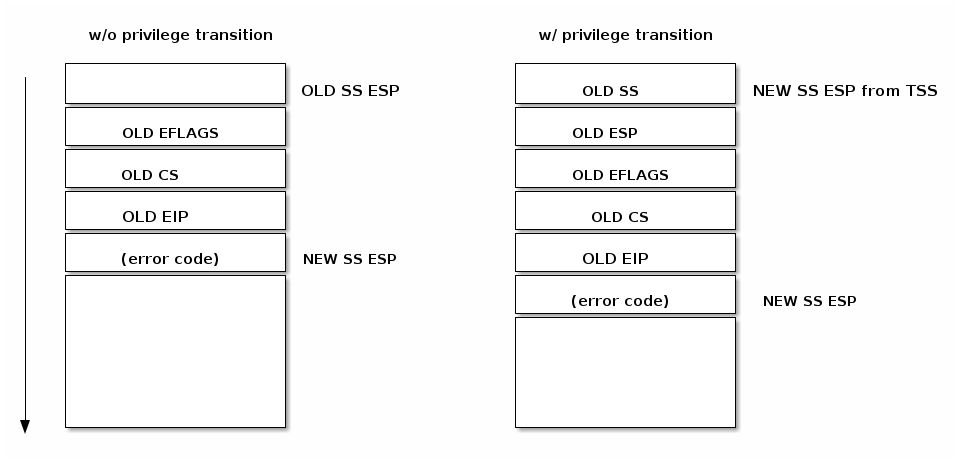JOS和抢占式内核的一点随想
几年前,我在面试现在的公司的时候,被问过一个很经典的问题
抢占式的内核是怎么工作的?
那个时候我对OS的调度流程理解很肤浅,并且也没有过hands-on experiences,读Linux内核的一些书其实也没有真正理解整个软件+硬件的行为。
只能凭着过去 CS 537和本科时候一点OS课的经验,泛泛的回答了一点 time slice,调度器,优先级之类的名词,结合自己想象中的流程瞎扯了一通。
听完我的回答后,我还记得谷雨并不满意的说道,“不是这样的。” 我们那个时候在用RTOS,做开发时,对进程调度,抢占式内核的理解是很重要的。
不过谢天谢地,最后大佬们还是offer了我,把对OS渣理解的我捞了起来。但是这个事情让我一直耿耿于怀,以至于后面有机会学习6.828的JOS,真正自己动手做round-robin的调度器、抢占式内核的时候,这个知识点还是我着重想去理解的地方。
闲话少说,关于JOS的preemptive multitasking,这里记录一些重要的细节以及个人理解:
- JOS 的preemptive 只能在CPU运行在user mode的时候进行抢占,进入kernel 后会关中断,就无法触发抢占操作。(注册IDT时必须走interrupt gates,而不是trap gates)
-
The IF (interrupt-enable flag) controls the acceptance of external interrupts signalled via the INTR pin. When IF=0, INTR interrupts are inhibited; when IF=1, INTR interrupts are enabled. As with the other flag bits, the processor clears IF in response to a RESET signal. The instructions CLI and STI alter the setting of IF.
CLI (Clear Interrupt-Enable Flag) and STI (Set Interrupt-Enable Flag) explicitly alter IF (bit 9 in the flag register). These instructions may be executed only if CPL <= IOPL. A protection exception occurs if they are executed when CPL > IOPL.
The IF is also affected implicitly by the following operations:
Interrupts through interrupt gates automatically reset IF, disabling interrupts. (Interrupt gates are explained later in this chapter.)
(x86 i386手册)
-
我们用了 i386 interupt gates注册了INT 31和所有的外部中断,所以发生系统调用和外部中断的时候,会自动reset EFLAGS里的IF 。
- 设置系统调用和抢断时钟中断的gate (第二个参数为0, 0 for an interrupt gate)
SETGATE(idt[T_SYSCALL], 0, GD_KT, t48_entry, 3); SETGATE(idt[IRQ_OFFSET + IRQ_TIMER], 0, GD_KT, irq_timer, 0);
- x86 setgate x86 setgate
1 // Set up a normal interrupt/trap gate descriptor. 2 // - istrap: 1 for a trap (= exception) gate, 0 for an interrupt gate. 3 // see section 9.6.1.3 of the i386 reference: "The difference between 4 // an interrupt gate and a trap gate is in the effect on IF (the 5 // interrupt-enable flag). An interrupt that vectors through an 6 // interrupt gate resets IF, thereby preventing other interrupts from 7 // interfering with the current interrupt handler. A subsequent IRET 8 // instruction restores IF to the value in the EFLAGS image on the 9 // stack. An interrupt through a trap gate does not change IF." 10 // - sel: Code segment selector for interrupt/trap handler 11 // - off: Offset in code segment for interrupt/trap handler 12 // - dpl: Descriptor Privilege Level - 13 // the privilege level required for software to invoke 14 // this interrupt/trap gate explicitly using an int instruction. 15 #define SETGATE(gate, istrap, sel, off, dpl) \ 16 { \ 17 (gate).gd_off_15_0 = (uint32_t) (off) & 0xffff; \ 18 (gate).gd_sel = (sel); \ 19 (gate).gd_args = 0; \ 20 (gate).gd_rsv1 = 0; \ 21 (gate).gd_type = (istrap) ? STS_TG32 : STS_IG32; \ 22 (gate).gd_s = 0; \ 23 (gate).gd_dpl = (dpl); \ (gate).gd_p = 1; \ 24 (gate).gd_off_31_16 = (uint32_t) (off) >> 16; \ 25 }
- 内核在通过 gate时(无论从 kernel mode 还是user mode),都会保存当前的eflags,这是i386的硬件行为(跳转到 ISR之前)
- 退出内核或者中断时,使用 IRET 退出,会自动pop出来eflags。如果之前user mode打开了中断,这时就会重新恢复中断
- 退出中断或者系统调用的代码
env_pop_tf(struct Trapframe *tf) { // Record the CPU we are running on for user-space debugging curenv->env_cpunum = cpunum(); asm volatile( "\tmovl %0,%%esp\n" "\tpopal\n" "\tpopl %%es\n" "\tpopl %%ds\n" "\taddl $0x8,%%esp\n" /* skip tf_trapno and tf_errcode */ "\tiret\n" : : "g" (tf) : "memory");
panic("iret failed"); /* mostly to placate the compiler */ }
-
- 关于 IRET
- IRET是个很复杂的操作。行为取决于 中断进入时栈上的EFLAGS以及当前的EFLAGS 中的VM项,以及NT 项。
- IRET可以进行的跳转模式
- Return from virtual-8086 mode.
- Return to virtual-8086 mode.
- Intra-privilege level return.
- Inter-privilege level return.
- Return from nested task (task switch).
- 在JOS里,由于kernel mode下关了中断,所以所有的iret最终都会到user mode。这个和Linux 2.6以前的行为是一致的。Linux 2.6以后加了内核态抢占,就复杂了很多
- IRET最核心的还是 恢复几个寄存器:
![中断(或者syscall)的硬件压栈行为 中断(或者syscall)的硬件压栈行为]()
-
所谓中断上下文,从硬件的角度来看,就是kernel stack上会多几个旧的寄存器值,并且切换ss + cs + ip,再加上关闭中断。 至于push哪些,取决于是否穿越 privilege。我们现实生活中说的中断上下文(只能使用自旋锁,以及不能sleep等约束),是可以由OS软件定义的行为,你自己也可以写一个一进ISR就把中断打开的软件(这当然很蠢)。
- 关于Blocking的Syscall
- JOS的抢占式内核,只能做User Mode下的抢占。所以系统调用间的控制转移,是cooperative模式,而非preemptive模式(这个名词时LKD里面提到的)
- 所谓合作式,就是在某个blocking系统调用 yield() + not_runnable 之后,后半部分,需要另外的系统调用来处理。
- 这个地方的处理,除了准备数据,就是准备返回值(ax)。一旦从not_runnable改变为runnable,那么重新运行的点,JOS会直接返回user mode
- 因为env_run会直接pop_tf,tf就是进入sys_call时的user mode点。
- sys_ipc_recv,yield之后的代码是永远不会被执行的,除非改变stack frame。
- sys_ipc_send 需要 把rcv调用的ax返回值准备好。否则会返回syscall num。
- Linux内核的抢占方式
- 内核在2.6以后全面支持了 kernel mode的抢占。一旦打开中断 (或者放掉锁, 大多数锁是会关掉中断的),在kernel mode也会被抢占
- yield时的context switch,会把 kernel stack也保存起来。通过_switch_to调用,部分clobbers寄存器是通过 call 自动压栈 来保存的
- signal 会将wait_interruptable的 process唤醒,所以要用mesa语义来检查是否是spurious唤醒。请使用推荐的wait - awake流程
- 由于有内核抢占 + 信号中断的情况,可能还是要注意可重入的问题
先写到这里吧





 浙公网安备 33010602011771号
浙公网安备 33010602011771号